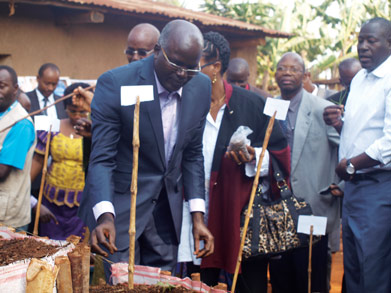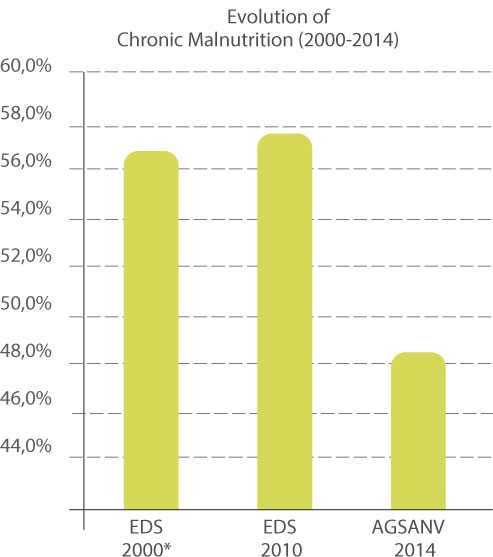Strengthening actions for Nutrition
67% of the population of Burundi live below the poverty line. 35.6% of the population suffer from high hunger levels (Global Hunger Index, 2014). Per capita calorie intake is the lowest in the East African region (1,600 Kcal/day). The fact that agricultural and livestock production have been structurally lacking since the year 2000 (+/-30% of annual requirements) due to high food prices, the exchange rate and demographic pressure, demonstrates how inextricably entwined the issues of malnutrition and food insecurity are.
[vc_row row_type=”row” text_align=”left” css_animation=””][vc_column width=”1/2″]

Dr. Déo-Guide RUREMA, Deputy Chief of the Office of the 2nd Vice-president
[/vc_column_text][/vc_column][/vc_row][vc_row row_type=”row” text_align=”left” css_animation=””][vc_column][vc_separator type=”transparent”][/vc_column][/vc_row][vc_row row_type=”row” text_align=”left” css_animation=””][vc_column]
[vc_column_text custom_options=””]“Investment in food security and nutrition is a prerequisite for sustainable development.”
SE Dr Ir Gervais RUFYIKIRI,
Second Vice-President of the Republic (Opening of the first forum on food security and nutrition)
[/vc_column_text][/vc_column][/vc_row][vc_row row_type=”row” text_align=”left” css_animation=””][vc_column][vc_separator type=”transparent”][/vc_column][/vc_row][vc_row row_type=”row” text_align=”left” css_animation=””][vc_column][vc_column_text custom_options=””]67% of the population of Burundi live below the poverty line. 35.6% of the population suffer from high hunger levels (Global Hunger Index, 2014). Per capita calorie intake is the lowest in the East African region (1,600 Kcal/day). The fact that agricultural and livestock production have been structurally lacking since the year 2000 (+/-30% of annual requirements) due to high food prices, the exchange rate and demographic pressure, demonstrates how inextricably entwined the issues of malnutrition and food insecurity are. Therefore, the Government of Burundi, is working to integrate the agricultural and social sectors to combat malnutrition and food insecurity.[/vc_column_text][/vc_column][/vc_row][vc_row row_type=”row” text_align=”left” css_animation=””][vc_column][vc_separator type=”transparent”][/vc_column][/vc_row][vc_row row_type=”row” text_align=”left” css_animation=””][vc_column][vc_column_text custom_options=””]
Multi-sectoral systems to address malnutrition
Thanks to sustained advocacy and awareness-raising actions, high-level political interest in malnutrition and food security issues have now become a reality in Burundi. Nutritional governance, formalised by Decree No 100/31 of 18 February 2014, is organised through the Multi-sectoral Food and Nutritional Security Platform (PMSAN), which oversees food security and nutrition activities. It is comprised of a steering committee, a Scaling Up Nutrition (SUN)/ Renewed Efforts Against Child Hunger (REACH) secretariat and a technical committee.
The steering committee includes high-level members such as the second Vice-President of the Republic, the Ministers of Public Health and the Fight against AIDS, Agriculture and Livestock, Commerce and Industry,
Finance and Economic Development Planning, Water, Environment, Land Management and Public Works, Community Development, National Solidarity, Human Rights and Gender.
In order to drive the necessary initiatives to improve nutrition, the steering committee is in charge of:
- Integrating food security and nutrition indicators into sector-based plans
- Approving sector-based food security and nutrition policies and plans, and supervising policies and programmes
- Introducing a dedicated budget line in each relevant ministerial budget.
[/vc_column_text][/vc_column][/vc_row][vc_row row_type=”row” text_align=”left” css_animation=””][vc_column][vc_separator type=”transparent”][/vc_column][/vc_row][vc_row row_type=”row” text_align=”left” css_animation=””][vc_column][vc_column_text custom_options=””]
Integrating nutrition into sectoral and development policies
Agricultural policies and strategies integrate nutrition through actions targeting vulnerable populations, in order to increase food production, access to food and food diversity. In the first semester of 2014, at the request of the steering committee, the SUN/REACH secretariat gave its support in identifying the priorities of the Multi-sectoral Strategic Plan for Food Security and Nutrition (MSPFSN), targeting landmark community actions and activities to be implemented in the short and medium term. The secretariat also supported efforts relating to information, communication and awareness-raising, which focused on changing habits and behaviours in favour of good nutrition practices.
The objectives of the MSPFSN are the outcome of an inclusive and participatory process and address, among other things, micronutrient deficiencies and chronic food security deficits. The two priorities identified for inauguration of the plan, were the promotion of:
- Kitchen gardens for households and schools in order to diversify diets. Traditional heads, agricultural instructors, health workers were trained in 6 of the 17 provinces, with a view to achieving national coverage by the end of 2016.
- Hand washing, through the popularisation of the tippy-tap or Kandagira Ukarabe (devices manufactured using local materials).
In parallel, food security and nutrition are among the priorities of the Strategic Framework for Growth
and Poverty Reduction (2012-2015). Its objective in the agricultural sector is to “provide Burundians with food of sufficient quality, in sufficient quantity and to reduce the percentage of the population that is underweight from 29% to 21% in 2015”.
The 2011-2015 National Health Development Plan (PNDS) and the 2012-2017 National Agricultural Sector Investment Plan (PNIA), both attach a great deal of importance to people’s access to nutritious agricultural products, such as vegetables, and recognition of challenges posed by climate change. Strengthening actions in the fight against malnutrition is an integral part of strategic pillar 1 of the 2011–2015 PNDS on transmissible and non-transmissible illnesses. Under its programme “sustainable increases in food production and food security”, the PNIA includes a sub-programme specifically relating to nutrition in connection with vulnerability, which aims to reduce the number of people in situations of sustained extreme food insecurity for more than three months. The main pillars of the PNIA include:
Pillar 1: Improving agricultural productivity by intensifying the agricultural sector, stimulated by the greater number of high-yield seeds distributed (manioc, sweet potato, banana, fruit, vegetables, macadamia nuts, etc.). This will ultimately increase food production and diversity. Subsidies for chemical fertilisers have also made it possible to double the quantity of fertilisers used for greenhouse crops.
Pillar 2: Intensifying meat and milk production by distributing animals to vulnerable families. The beneficiaries are chosen by the population in a participatory and inclusive manner and community solidarity chain monitoring committees will identify subsequent generations of beneficiaries. The animals (cattle, goats, pigs, rabbits and chickens) are chosen according to the families’ capacities, the poorest receiving small livestock, and other landowners receiving cattle. In 2013, 9,800 head of cattle were
distributed to rural families.
Pillar 3: Developing the fish farming and aquaculture sectors. Although the PNIA provided for the creation of 100 ponds, there were over 5,000 in operation by the end of 2014.[/vc_column_text][/vc_column][/vc_row][vc_row row_type=”row” text_align=”left” css_animation=””][vc_column][vc_separator type=”transparent”][/vc_column][/vc_row][vc_row row_type=”row” text_align=”left” css_animation=””][vc_column][vc_column_text custom_options=””]
 [/vc_column_text][/vc_column][/vc_row][vc_row row_type=”row” text_align=”left” css_animation=””][vc_column][vc_separator type=”transparent”][/vc_column][/vc_row][vc_row row_type=”row” text_align=”left” css_animation=””][vc_column][vc_column_text custom_options=””]
[/vc_column_text][/vc_column][/vc_row][vc_row row_type=”row” text_align=”left” css_animation=””][vc_column][vc_separator type=”transparent”][/vc_column][/vc_row][vc_row row_type=”row” text_align=”left” css_animation=””][vc_column][vc_column_text custom_options=””]
Conclusion
Although agricultural production increased by around 35% between 2011 and 2013, the chronic and acute malnutrition rates in children under five fell from 58% and 6% respectively in 2010 to 48.9% and 5.4% respectively in 2014. While it’s not possible to directly correlate the fall in malnutrition with the progress of the agricultural sector, it certainly had an impact.
 [/vc_column_text][/vc_column][/vc_row][vc_row row_type=”row” text_align=”left” css_animation=””][vc_column][vc_separator type=”transparent”][/vc_column][/vc_row][vc_row row_type=”row” text_align=”left” css_animation=””][vc_column][vc_column_text custom_options=””]
[/vc_column_text][/vc_column][/vc_row][vc_row row_type=”row” text_align=”left” css_animation=””][vc_column][vc_separator type=”transparent”][/vc_column][/vc_row][vc_row row_type=”row” text_align=”left” css_animation=””][vc_column][vc_column_text custom_options=””]
Challenges
Some key challenges to effective strengthening of mutlisectoral efforts with a focus on agriculture and social protection include:
- Harmonising and aligning points of view, practices and customs between the ministries, non-government organisations (NGOs) and donors working for food security and nutrition
- The budget for the MSPFN needs to be finalised in order to pave the way for resource mobilisation
- Certain sectors such as social and environmental protection could still be better represented in the PMSAN
- Promoting behavioural change and the adoption of best practices and habits in food and agricultural production is still not easy
- Understanding the underlying causes of malnutrition and its medium and long term effects remains challenging in a context of transition from family subsistence agriculture to intensive agro-pastoral production less dependent on climatic conditions.
[/vc_column_text][/vc_column][/vc_row][vc_row row_type=”row” text_align=”left” css_animation=””][vc_column][vc_separator type=”transparent”][/vc_column][/vc_row][vc_row row_type=”row” text_align=”left” css_animation=””][vc_column]
Key Lessons
- The first forum on food security and nutrition, from 1 to 14 December 2011, played a key role in raising awareness and garnering political commitment at a highlevel, regarding the issues of malnutrition and food insecurity
- Participating in the SUN Movement and the REACH initiative has also improved the organisation and coordination of national activities and helped address the multiple causes of malnutrition in a multisectoral and multi-stakeholder approach
- Distributing cattle to rural families has significantly increased milk production and consumption
- Promoting organic fertilizers and kitchen gardens as well as credit facilities and fertilizer subsidies has increased and diversified agricultural production and consequently increased consumption in the population (especially of vegetables)
- Regarding social protection, identifying appropriate beneficiaries for the distribution of animals to vulnerable families is crucial and an identification mechanism has been established for future generations.
